Content for TS 23.303 Word version: 17.1.0
5.3.5 Announcing Alert Procedures - restricted discovery
5.3.5.1 Announcing Alert (non-roaming)
5.3.5.2 Announcing Alert (roaming)
5.3.6A Direct Discovery Update Procedures
5.3.6A.1 Discovery Update - open discovery
5.3.6A.1.1 General
5.3.6A.1.2 Network-initiated discovery update procedure
5.3.6A.1.3 UE initiated discovery update procedures
5.3.6A.1.3.1 Stop announce procedure
5.3.6A.1.3.2 Stop monitor procedure
5.3.6A.2 Discovery Authorization Update - restricted discovery
5.3.6A.2.1 General
5.3.6A.2.2 Revocation of Discovery Filters
5.3.6A.2.3 Allocation of a new ProSe Restricted Code and update of Discovery Filters
5.3.7 Direct Discovery for Public Safety use
...
...
5.3.5 Announcing Alert Procedures - restricted discovery |R13| p. 91
5.3.5.1 Announcing Alert (non-roaming) p. 91
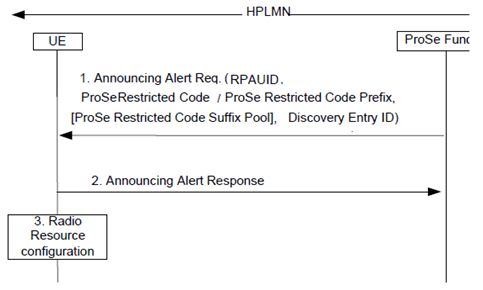
In non-roaming case, when the ProSe Function in the HPLMN of the announcing UE receives a Monitor Request from a UE which is in the vicinity of the announcing UE and detects the associated Announcing Enabled indication stored in the announcing UE context, the ProSe Function triggers an Announcing Alert procedure towards the announcing UE in HPLMN.
Step 1.
The HPLMN ProSe Function informs the announcing UE with the Announcing Alert Request (RPAUID, ProSe Restricted Code, Discovery Entry ID) message. The RPAUID indicates what the UE is interested to announce which was obtained in step 0 of Announce Request procedure in clause 5.3.3.2A and clause 5.3.3.3A. The Application ID represents a unique identifier of the UE application that has triggered the transmission of the Discovery Request message. The ProSe Restricted Code is retrieved from the announcing UE context. If restricted Direct Discovery with application-controlled extension was requested by the announcing UE, the ProSe Restricted Code is replaced by the ProSe Restricted Code Prefix, and the Announcing Alert Request message also contains the ProSe Restricted Code Suffix pool for the RPAUID retrieved from the announcing UE context.
Step 2.
The UE responds with an Announce Alert Response message to the ProSe Function. Upon receiving the Announce Alert Response message the ProSe Function removes the Announcing Enabled indication associated to that ProSe Restricted Code from the user context.
Step 3.
The UE may start announcing the provided ProSe Restricted Code in the serving PLMN, using the radio resources authorised and configured by E-UTRAN to be used for ProSe as defined in RAN specifications.
5.3.5.2 Announcing Alert (roaming) p. 92
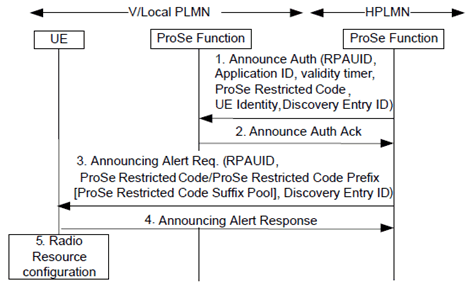
The UE is only allowed to announce in the carrier frequency signalled from serving PLMN. When inter-PLMN discovery transmission is supported, the carrier frequency may be operated by Local PLMN.
In roaming case or UE performs inter-PLMN discovery transmission, when the ProSe Function in the HPLMN of the announcing UE receives a Monitor Request from a UE which is in the vicinity of the announcing UE and detects the associated Announcing Enabled indication stored in the UE context, the ProSe Function triggers an Announcing Alert procedures towards the announcing UE in VPLMN or Local PLMN.
Step 1.
The HPLMN ProSe Function informs the ProSe Function in VPLMN or Local PLMN with the Announce Authorization (RPAUID, Application ID, validity timer, ProSe Restricted Code, UE Identity, Discovery Entry ID) message. The RPAUID and Application ID correspond to the request from the UE, whereas the ProSe Restricted Code indicates the assigned code for this request and retrieved from the announcing UE context. The request shall include the UE identity information e.g. IMSI or MSISDN and validity timer in order to allow the ProSe Function in VPLMN or Local PLMN to perform charging. The validity timer indicates for how long this ProSe Restricted Code is going to be valid. If the ProSe Function in VPLMN or Local PLMN receives the same Discovery Entry ID in a subsequent Announce Authorization message, it updates the announcing UE's corresponding discovery entry replacing the existing ProSe Restricted Code and validity timer with the last received ones.
Step 2.
The ProSe Function in VPLMN or Local PLMN authorizes the UE to perform Restricted ProSe Discovery announcing.
Step 3.
The HPLMN ProSe Function informs the announcing UE with the Announcing Alert Request (RPAUID, ProSe Restricted Code, Discovery Entry ID) message. The RPAUID indicates what the UE is interested to announce which was obtained in step 0 of Announce Request procedure in clause 5.3.3.2A and clause 5.3.3.3A. The Application ID represents a unique identifier of the UE application that has triggered the transmission of the Discovery Request message. The ProSe Restricted Code is retrieved from the announcing UE context. If restricted Direct Discovery with application-controlled extension was requested by the announcing UE, the ProSe Restricted Code is replaced by the ProSe Restricted Code Prefix, and the Announcing Alert Request message also contains the ProSe Restricted Code Suffix pool for the RPAUID retrieved from the announcing UE context.
Step 4.
The UE responds with an Announce Alert Response message to the ProSe Function. Upon receiving the Announce Alert Response message the ProSe Function removes the Announcing Enabled indication associated to that ProSe Restricted Code from the user context.
Step 5.
The UE may start announcing the provided ProSe Restricted Code in the serving PLMN, using the radio resources authorised and configured by E-UTRAN to be used for ProSe as defined in RAN specifications.
5.3.5A Void
5.3.6 Void
5.3.6A Direct Discovery Update Procedures |R13| p. 93
5.3.6A.1 Discovery Update - open discovery p. 93
5.3.6A.1.1 General p. 93
The ProSe Function can at any time update/revoke a previously allocated ProSe Application Code, or Discovery Filters.
The UE can decide at any time to stop announcing a ProSe Application Code or monitoring set of Discovery Filter(s).
5.3.6A.1.2 Network-initiated discovery update procedure p. 94
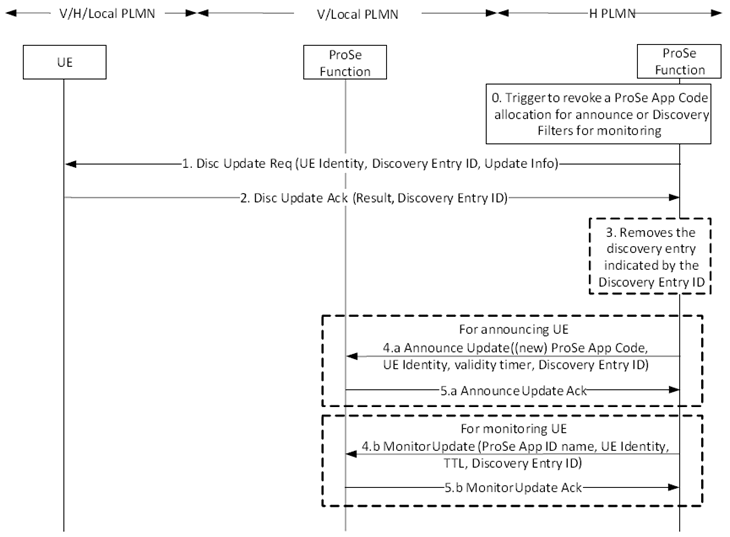
Step 0.
Steps 4.a-5.a are executed only when the UE is an announcing UE and is roaming or only when UE is an announcing UE and performs inter-PLMN discovery transmission and the ProSe Application ID announced has PLMN-specific scope excluding the HPLMN..
The ProSe Function is triggered to update or revoke the ProSe Application Code previously allocated to an announcing UE ,or the Discovery Filters allocated to a monitoring UE.
Step 1.
The ProSe Function sends a Discovery Update Request (UE Identity, Discovery Entry ID, Update Info) message to the UE. The UE identity is set to the IMSI of the UE. The Discovery Entry ID is set to the identifier of the corresponding discovery entry that contains the ProSe App Code (or Discovery Filters) to be updated or revoked. The Update Info is optional, and contains the ProSe App Code and validity timer for an announcing UE, or Discovery Filters for a monitoring UE. If the Update Info is included, the UE shall replace the existing parameters with those in the Update Info. If the Update Info is not included, the UE shall remove the ProSe App Code or Discovery Filter(s) corresponding to the Discovery Entry ID.
Step 2.
The UE responds with a Discovery Update Ack (Result, Discovery Entry ID) to the ProSe Function to confirm the corresponding operation. If a ProSe Application Code has been revoked, then the UE informs the lower layers to take any appropriate action.
Step 3.
If a ProSe Application Code or Discovery Filter(s) have been revoked, then the ProSe Function removes the discovery entry indicated by the Discovery Entry ID, and releases the associated resources
Step 4.a.
Alternative steps 4.b-5.b are executed only when the UE is a monitoring UE and the ProSe Application ID monitored has PLMN-specific scope other than that of the HPLMN.
The HPLMN ProSe Function shall inform the ProSe Function in VPLMN or Local PLMN with an Announce Update ((new) ProSe Application Code, UE Identity, validity timer, Discovery Entry ID) message.
Step 5.a.
The ProSe Function in VPLMN or Local PLMN responds wtih an Announce Update Ack message.
5.3.6A.1.3 UE initiated discovery update procedures p. 95
5.3.6A.1.3.1 Stop announce procedure p. 95
When the Announcing UE wants to stop announcing a ProSe Application Code before the associated validity timer expires, it shall issue a Discovery Request with the Requested Timer set to zero to enable the ProSe Function to remove the discovery entry indicated by the Discovery Entry ID, and release the associated resources.
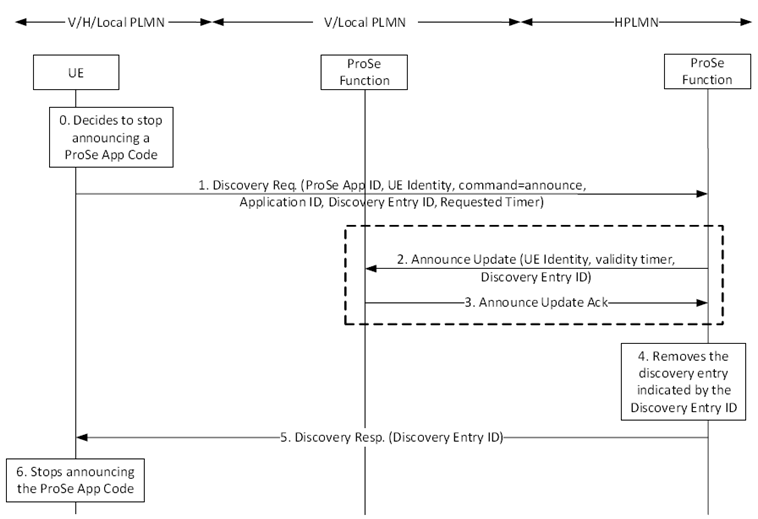
Step 0.
Steps 2-3 are executed only when the UE is roaming or only when UE performs inter-PLMN discovery transmission and the ProSe Application ID announced has PLMN-specific scope excluding the HPLMN.
The UE decides to stop announcing a ProSe Application Code before the associated validity timer expires.
Step 1.
The UE shall establish a secure connection with the ProSe Function in HPLMN and shall then send a Discovery Request message identical to that of clause 5.3.3.3 with the Discovery Entry ID that corresponds to the ProSe Application Code the UE wants to stop announcing, and the Requested Timer set to zero.
Step 2.
The HPLMN ProSe Function shall inform the ProSe Function in VPLMN or Local PLMN that a previously allocated ProSe Application Code, corresponding to a given Discovery Entry ID, is no longer being announced with an Announce Update (UE Identity, validity timer, Discovery Entry ID) message that does not include a ProSe Application Code and with the validity timer set to zero.
Step 3.
The ProSe Function in VPLMN or Local PLMN responds with an Announce Update Ack message.
Step 4.
The ProSe Function removes the discovery entry indicated by the Discovery Entry ID, and releases the associated resources.
Step 5.
The ProSe Function in HPLMN shall respond to the UE with a Discovery Response (Discovery Entry ID) message containing only the Discovery Entry ID.
Step 6.
The UE removes and stops announcing the ProSe App Code corresponding to the Discovery Entry ID, and informs the lower layers to take any appropriate action.
5.3.6A.1.3.2 Stop monitor procedure p. 96
When the Monitoring UE wants to stop monitoring before the expiration of the TTLs for the Discovery Filter(s) in a discovery entry it shall issue a Discovery Request with the Requested Timer set to zero to enable the ProSe Function to remove the discovery entry indicated by the Discovery Entry ID, and release the associated resources.
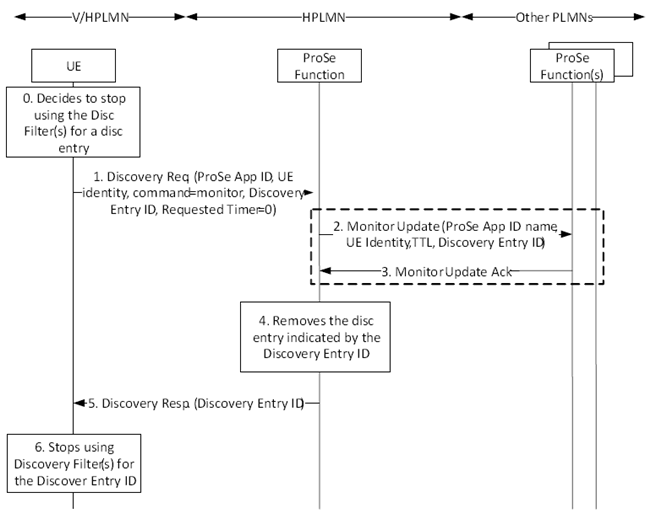
Step 0.
Steps 2-3 are executed only when the ProSe Application ID of the Discovery Entry has PLMN-specific scope other than that of the HPLMN.
The UE decides to stop monitoring before the expiration of the TTL(s) of the Discovery Filter(s) of a certain Discovery Entry.
Step 1.
The UE shall establish a secure connection with the ProSe Function in HPLMN and shall then send a Discovery Request message identical to that of clause 5.3.3.4 or 5.3.3.5, with the Discovery Entry ID that corresponds to the Discovery Filter(s) the UE wants to stop using for monitoring, and the Requested Timer set to zero.
Step 2.
The HPLMN ProSe Function shall inform the ProSe Function in the other PLMN that the ProSe Application ID name, corresponding to a given Discovery Entry ID, is no longer being monitored for this UE with a Monitor Update (ProSe Application ID name, UE Identity, TTL, Discovery Entry ID) message where the TTL is set to zero.
Step 3.
The ProSe Function in the other PLMN responds with a Monitor Update Ack message.
Step 4.
The ProSe Function removes the discovery entry indicated by the Discovery Entry ID and releases the associated resources.
Step 5.
The ProSe Function in the HPLMN shall respond to the UE with a Discovery Response (Discovery Entry ID) message containing only the Discovery Entry ID.
Step 6.
The UE removes and stops using for monitoring the Discovery Filter(s) corresponding to the Discovery Entry ID.
5.3.6A.2 Discovery Authorization Update - restricted discovery p. 97
5.3.6A.2.1 General p. 97
A user may decide at any time to change the discovery permissions relating to other users in a ProSe Application Server.
For example user A, while announcing the ProSe Restricted Code for a given Application ID, may revoke the permission to be discovered by users B and C. However, changes in the discovery permissions will not be effective until the validity timer associated to the corresponding ProSe Restricted Code expires. In order to avoid such a delay, the procedure in clause 5.3.6A.2.2 is triggered by the ProSe Application Server towards the ProSe Function serving user A.
5.3.6A.2.2 Revocation of Discovery Filters p. 98
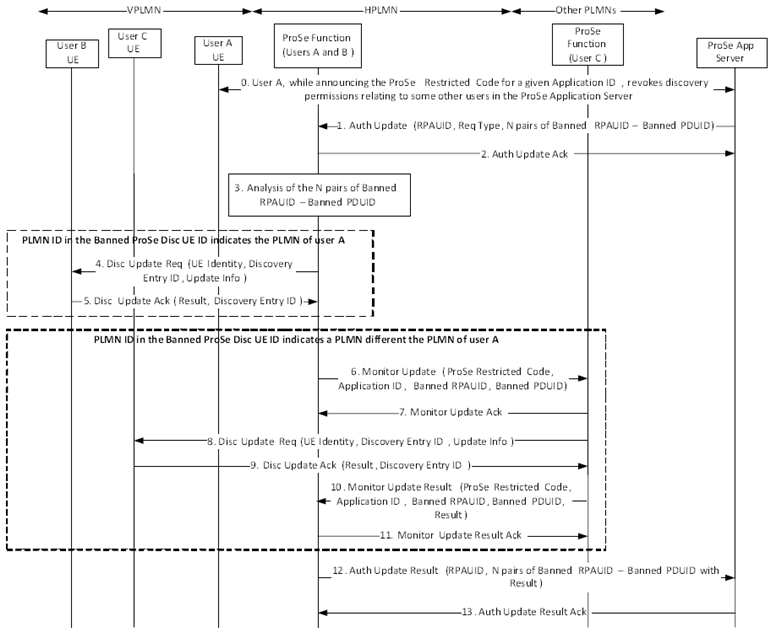
Figure 5.3.6A.2.2-1: Revocation of Discovery Filters for restricted discovery (roaming or non-roaming)
(⇒ copy of original 3GPP image)
(⇒ copy of original 3GPP image)
Step 0.
Steps 4 - 5 are executed only for the (sub)set of Banned PDUIDs whose PLMN ID is the same PLMN ID of the PDUID associated with the RPAUID of user A (e.g. UE of user B).
User A, while announcing the ProSe Restricted Code for a given Application ID, revokes discovery permissions relating to some other users in the ProSe Application Server.
Step 1.
The ProSe Application Server sends to the ProSe Function serving user A (identified by checking the PDUID of user A) an Authorization Update (RPAUID, Request Type, N sets of Banned RPAUID - Banned PDUID) message. ProSe Function identifies user A based on the RPAUID and the Application ID associated with the ProSe Application Server. The Request Type is set to "restricted discovery/monitor nack". The N sets of Banned RPAUID - Banned PDUID are those that are no longer allowed to discover the ProSe Restricted Code corresponding to user A's RPAUID for the Application ID associated with that ProSe Application Server.
Step 2.
The ProSe Function serving user A acknowledges the Authorization Update message.
Step 3.
The ProSe Function serving user A analyses the received N sets of Banned RPAUID - Banned PDUID.
Step 4.
Steps 6 - 11 are executed only for the (sub)set of Banned PDUIDs whose PLMN ID is different from the PLMN ID of the PDUID associated with the RPAUID of user A (e.g. UE of user C).
If the ProSe Function serving user A has previously allocated to a Banned RPAUID - Banned ProSe Discovery UE (e.g. user B) a Discovery Filter for monitoring the ProSe Restricted Code corresponding to the RPAUID and Application ID of user A, then the ProSe Function shall send a Discovery Update Request (UE Identity, Discovery Entry ID, Update Info) message to that UE (e.g. UE of user B). The UE identity is set to the IMSI of the UE. The Discovery Entry ID is set to the identifier of the corresponding Discovery Entry that contains the Discovery Filter to be revoked. The Update Info is optional and contains Discovery Filter(s) to replace the existing one(s), if the ProSe Function decides to remove only certain filter(s) and not others. If the Update Info is not included, the UE shall remove all the Discovery Filters corresponding to the Discovery Entry ID.
Step 5.
The UE locates each Discovery Filter to be revoked, associated with the Discovery Entry ID, removes it from the ProSe Discovery services operation and sends back to the ProSe Function a Discovery Update Ack (Result, Discovery Entry ID) message to confirm the corresponding operation.
Step 6.
If the ProSe Function serving user A has previously answered to a Monitor Request coming from a ProSe Function in the PLMN of a Banned PDUID, related to a Banned RPAUID (e.g. user C), then the ProSe Function serving user A sends to that ProSe Function a Monitor Update (ProSe Restricted Code, Application ID, Banned RPAUID, Banned PDUID) message. The ProSe Restricted Code is the code the UE of user A is announcing and for which is requested the revocation of the corresponding Discovery Filter. The Banned RPAUID and Banned PDUID identify the UE that is using the Discovery Filter to be revoked (e.g. UE of user C).
Step 7.
The ProSe Function in the other PLMN acknowledges the Monitor Update message.
Step 8.
Upon receiving the ProSe Function a Monitor Update, the ProSe Function in the other PLMN shall send a Discovery Update Request (UE Identity, Discovery Entry ID, Update Info) message to that UE (e.g. UE of user C). The UE identity is set to IMSI of the UE. The Discovery Entry ID is set to the identifier of the corresponding Discovery Entry that contains the Discovery Filter to be revoked. The Update Info is optional and contains Discovery Filter(s) to replace the existing one(s), if the ProSe Function decides to remove only certain filter(s) and not others. If the Update Info is not included, the UE shall remove all the Discovery Filters corresponding to the Discovery Entry ID.
Step 9.
The UE locates each Discovery Filter to be revoked, associated with the Discovery Entry ID, removes it from the ProSe Discovery services operation and sends back to the ProSe Function a Discovery Update Ack (Result, Discovery Entry ID) message to confirm the corresponding operation.
Step 10.
After a time configured by the operator the ProSe Function in the other PLMN sends a Monitor Update Result (ProSe Restricted Code, Application ID, Banned RPAUID, Banned ProSe Discovery UE ID, Result) message to the ProSe Function serving user A to report the result of the corresponding operation.
Step 11.
The ProSe Function serving user A acknowledges the Monitor Update Result message.
Step 12.
After a time configured by the operator, the ProSe Function serving user A sends an Authorization Update Result (RPAUID, Request Type, N sets of Banned RPAUID - Banned PDUID with Result) message to the ProSe Application Server. The sets Banned RPAUID - Banned PDUID are those received from the ProSe Application Server in step 1. For each set, the Result indicates whether the permission to discover the ProSe Restricted Code corresponding to user A RPAUID for the Application ID specific of that ProSe Application Server has been successfully revoked or not.
Step 13.
The ProSe Application Server acknowledges the Authorization Update Result message.
5.3.6A.2.3 Allocation of a new ProSe Restricted Code and update of Discovery Filters p. 99
Based on local policies the ProSe Function serving user A may decide that in certain scenarios it is more convenient to allocate a new ProSe Restricted Code to the user A and provide new corresponding Discovery Filters to the monitoring UEs that are still allowed to perform discovery of user A (e.g. UE of user D), rather than revoking the Discovery Filters from the monitoring UEs whose discovery permissions for user A have been revoked.
In such case the procedure is executed as shown in Figure 5.3.6A.2.3-1.
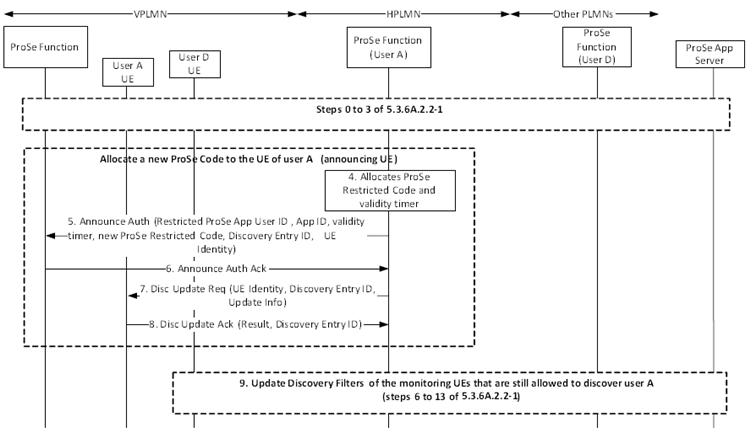
Figure 5.3.6A.2.3-1: Allocation of a new ProSe Restricted Code and update of Discovery Filters
(⇒ copy of original 3GPP image)
(⇒ copy of original 3GPP image)
Steps 0 - 3 are the same as in clause 5.3.6A.2.2.
Step 4.
Steps 5 and 6 are executed only when the UE of user A is roaming.
As step 3 in clause 5.3.3.2A and 5.3.3.3A with the following change: the ProSe Function stores the new ProSe Restricted Code and the associated validity timer in the user context and removes the old ProSe Restricted Code.
Step 5.
As step 4 in clause 5.3.3.3A.
Step 6.
As step 5 in clause 5.3.3.3A.
Step 7.
The ProSe Function serving user A sends a Discovery Update Request (UE Identity, Discovery Entry ID, Update Info) message to the UE of user A. The UE identity is set to IMSI of the UE. The Discovery Entry ID is set to the identifier of the corresponding Discovery Entry that contains the ProSe Restricted Code to be replaced. The Update Info contains the new ProSe Restricted Code and the associated validity timer that should be used.
Step 8.
The UE locates the ProSe Restricted Code to be replaced, associated with the Discovery Entry ID, replaces it and sends back to the ProSe Function a Discovery Update Ack (Result, Discovery Entry ID) message to confirm the corresponding operation.
Step 9.
If the Discovery Filters for monitoring the ProSe Restricted Code corresponding to the RPAUID and Application ID of user A has been previously allocated to a Target RPAUID - Target ProSe Disc UE still allowed to discover user A (e.g. user D), then those monitoring UEs are updated as described in Figure 5.3.6A.2.2-1, with the following changes: the newly allocated ProSe Restricted Code and validity timer are additionally delivered to the ProSe Function(s) serving the monitoring UEs (e.g. user D) by the Monitor Update message, and are used by the ProSe Function(s) to build the new Discovery Filters that were conveyed in the Update Info information element of the Discovery Update Request messages, and are used by the monitoring UEs to replace the old Discovery Filters. The ProSe Application Server is finally updated with the results of the overall procedure.
5.3.7 Direct Discovery for Public Safety use |R13| p. 100
5.3.7.1 General p. 100
The following functions for public safety direct discovery are supported:
- UE-to-Network Relay Discovery.
- Determination is needed regarding within the ProSe Communication which user(s) are in ProSe Communication range at any given time (shortly referred to as "Group Member Discovery").
- Model A uses a single discovery protocol message (Announcement).
- Model B uses two discovery protocol messages (Solicitation and Response).
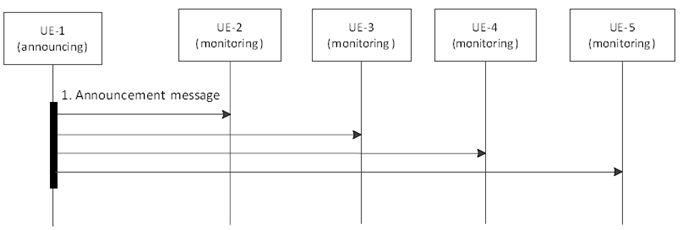
For UE-to-Network Relay Discovery:
Step 1.
The ProSe UE-to-Network Relay sends a UE-to-Network Relay Discovery Announcement message. The parameters contained in this message are described in clause 4.6.4.3.
For Group Member Discovery:
Step 1.
The announcing UE sends a Group Member Discovery Announcement message. The parameters contained in this message are described in clause 4.6.4.9.
For Relay Discovery Additional Information:
Step 1.
The ProSe UE-to-Network Relay sends a Relay Discovery Additional Information message. The parameters contained in this message are described in clause 4.6.4.10.
Depicted in Figure 5.3.7.1-2 is the procedure for public safety direct discovery with Model B.
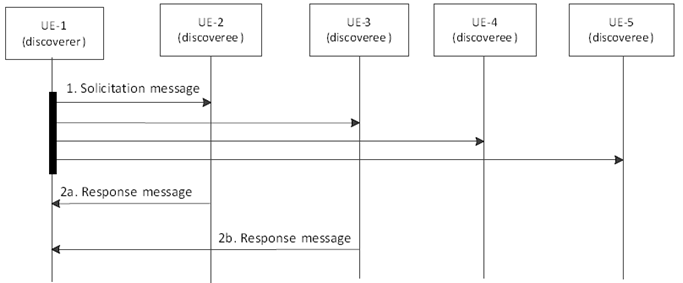
For UE-to-Network Relay Discovery:
Step 1.
For Group Member Discovery:
The Remote UE sends a UE-to-Network Relay Discovery Solicitation message. The parameters contained in this message are described in clause 4.6.4.3.
Step 2.
The ProSe UE-to-Network Relays that match the values of the Relay Service Code contained in the solicitation message respond to the Remote UE with a UE-to-Network Relay Discovery Response message. The parameters contained in this message are described in clause 4.6.4.3.
Step 1.
The discoverer UE sends a Group Member Discovery Solicitation message. The parameters contained in this message are described in clause 4.6.4.9.
Step 2.
The discoveree UEs that match the values of the parameters contained in the solicitation message based on the Discovery Group ID, respond to the discoverer UE with a Group Member Discovery Response message. The parameters contained in this message are described in clause 4.6.4.9.